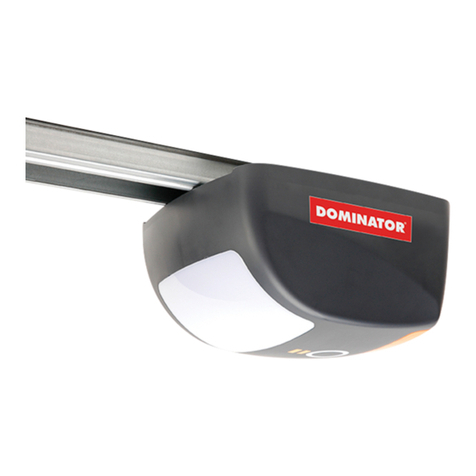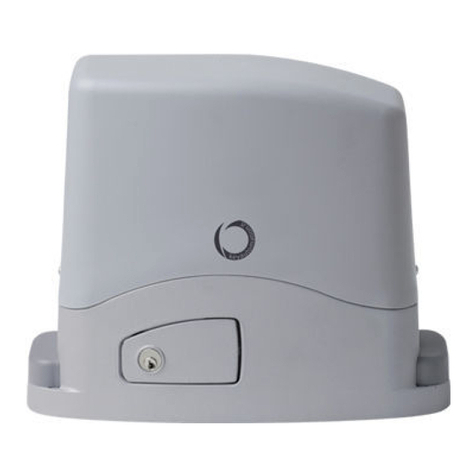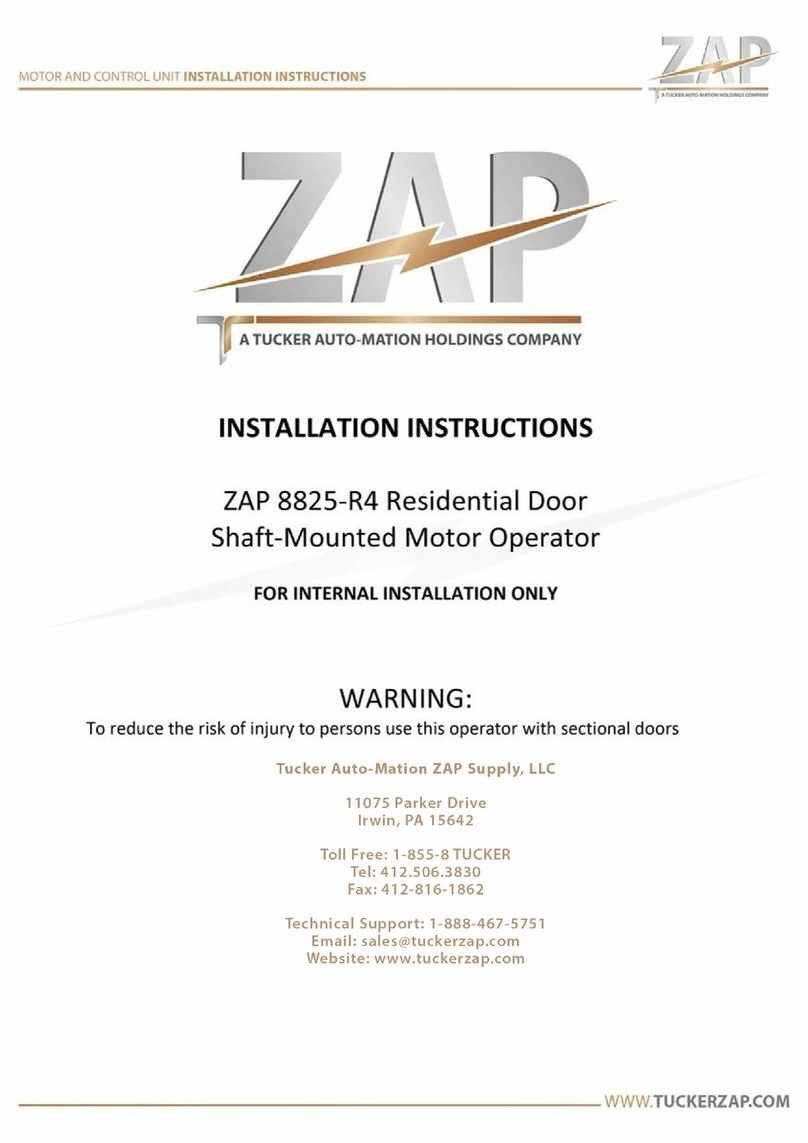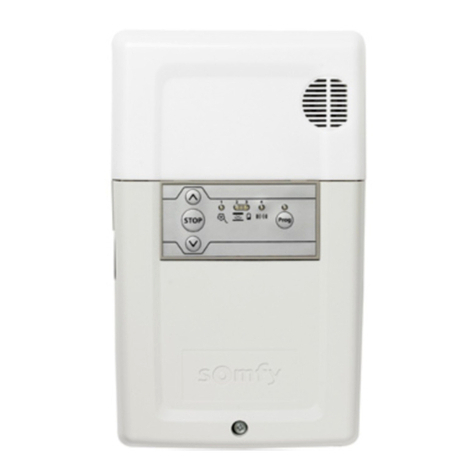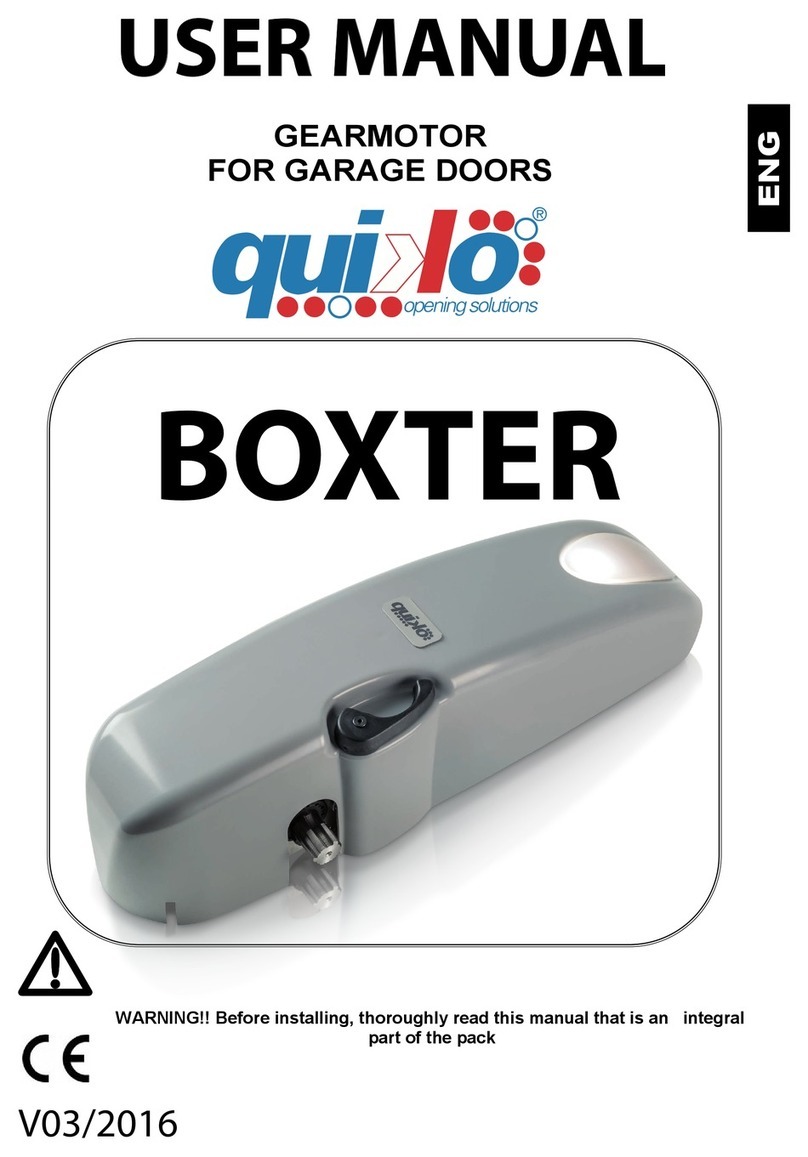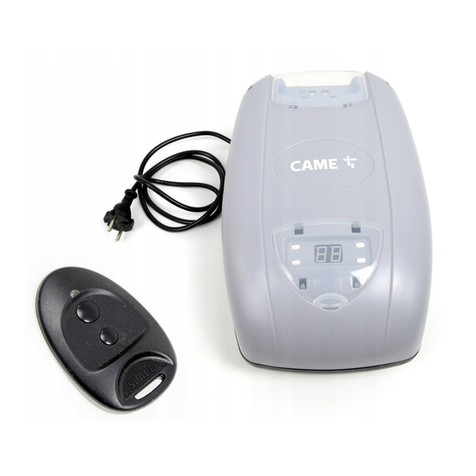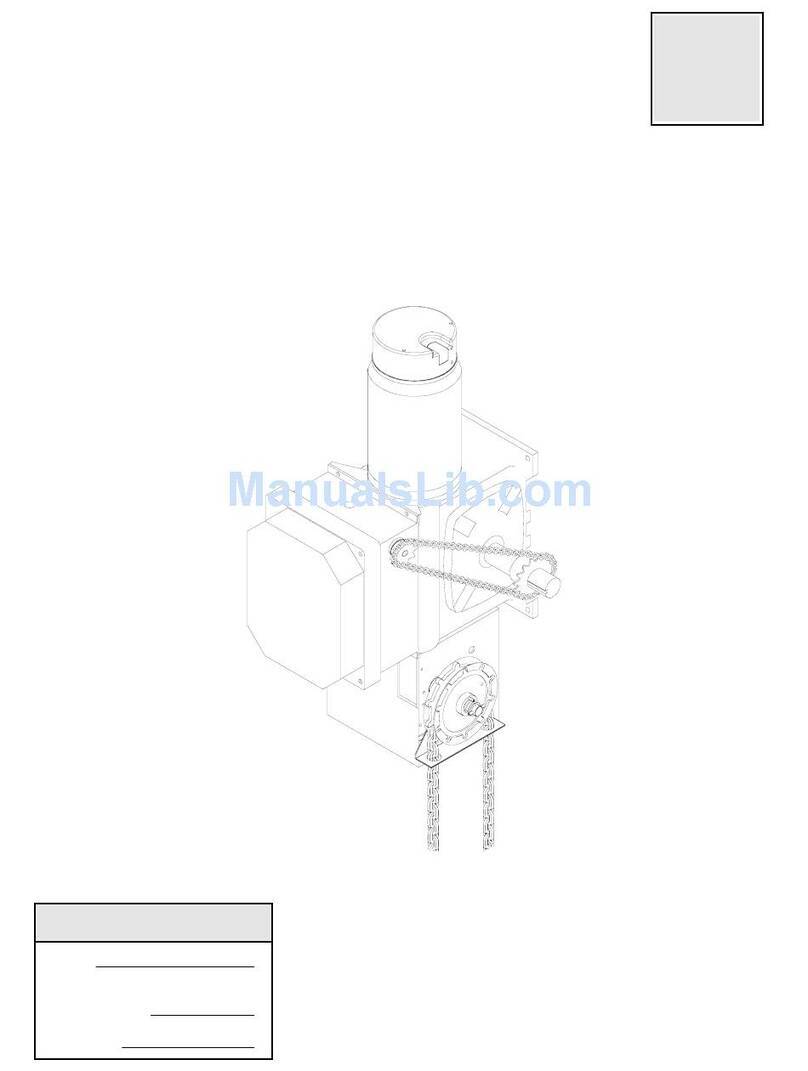Automatic Cobra User manual

Page 1
Cobra®
Overhead Garage Door Opener
Installation Manual

Page 2

Page 3
WARNING – IT IS VITAL FOR THE SAFETY
OF PERSONS TO FOLLOW ALL
INSTRUCTIONS. SAVE THESE
INSTRUCTIONS!
Watch the moving door and keep people away
until it is completely opened or closed. Do not
allow children to play with door controls. Keep
remote controls away from children.
Use caution when operating manual release if the
door is open, since it may fall rapidly if out of
balance or if springs are weak or broken.
Property damage or serious personal injury could
result.
Disconnect electric power to the garage door
opener before making repairs or removing
covers.
This product is provided with a power supply cord of
special design. If damaged, it must be replaced by a
cord of the same type obtained from your Automatic
Technology distributor, and must be specially fitted.
IMPORTANT SAFETY INSTRUCTIONS FOR INSTALLATION AND USE
These safety alert symbols mean WARNING – a personal safety or property damage instruction. This
garage door opener is designed and tested to offer reasonable safe service provided it is installed,
operated, maintained and tested in strict accordance with the instructions contained in this manual.
WARNING – INCORRECT INSTALLATION
CAN LEAD TO SEVERE INJURY. FOLLOW
ALL INSTALLATION INSTRUCTIONS.
Door must not extend over public footpaths or
roads during operation.
Install only on a properly balanced garage door in
good operating condition. Sticking or binding doors
must be repaired. Garage doors and components
attached to them are under extreme tension. Do not
attempt to repair or adjust them. Get professional
garage door service
This unit must be installed in a dry position that
is protected from the weather.
After installation and adjustment, ensure that your
garage door reverses on contact with a 40mm high
object placed on the floor. Repeat monthly and
adjust as necessary.
WARNING!
Please read the following information carefully.
Failure to comply with these instructions could result in:
• Death
• Serious Injury
• Damage to property
• Voiding of opener warranty
A B C
The Cobra® Overhead Garage Door Opener is suitable for the following types of doors:
A - One piece door with horizontal track
B - Sectional door with curved track
C - One piece door without track / J-Style tilt door

Page 4
Thank you!
Welcome to the installation and instruction manual for your new
Automatic Technology Cobra overhead garage door opener.
Created and designed by the latest technological advances, and using the best
possible components in the most stringent manufacturing processes athis opener
will provide many years of reliable, faithful and safe service to you and your family.
TABLE OF CONTENTS
PRODUCT FEATURES............................................................................................. 5
OPERATING CONTROLS........................................................................................6 - 8
INSTALLATION....................................................................................................... 9 - 16
DOOR TRAVEL LIMITS............................................................................................17
SAFETY FORCE MARGIN....................................................................................... 18
CODING/DELETING TRANSMITTERS....................................................................19 - 21
FIITING PE BEAMS..................................................................................................21
PROGRAMMING OPERATING MODES & COURTESY LIGHT.............................. 22 - 24
FACTORY DEfAULT SETTINGS & SPECIFICATIONS.............................................25
WARRANTY.............................................................................................................27

Page 5
PRODUCT FEATURES
OPERATION
To open or close the door simply press the hand held transmitter, the wall mounted transmitter, or optional wall
switch. During an open or close cycle the door can be stopped by pressing the button while the door is in motion.
The next actuation will move the door in the opposite direction.
SecruaCode® HOPPING CODE TECHNOLOGY
Every time a SecuraCode® transmitter is used, it generates a new access code from 4.29 billion possibilities. This ran-
dom process makes it is near impossile for unwanted operation of your Cobra® Overhead Garage Door Opener.
AUTO CALCULATE THE LIMITS AND SAFETY FORCE
During installation, after setting the open and close positions with your SecuraCode® transmitter, the Cobra® Over-
head Garage Door Opener automatcially measures the force required to move your door. These travel limits and the
safety force will be stored in the memory. Also, the current door position will be remembered during a power failure
or if the door is moved manually.
SAFETY OBSTRUCTION SYSTEM
Should the door contact an obstacle or be restricted in any manner while closing it will automatically reverse. This
level of safety force is automatically calculated when the Cobra® Overhead Garage Door Opener is initially installed.
The door will also stop if restricted whilst opening. The Safety Obstruction Force should be checked at least once a
month.
AUTO COURTESY LIGHT
A SecuraCode® transmitter button can be programmed to independantly operate the courtesy light. The courtesy
light also turns on with any door operation, shutting off after an adjustable specified time.
VACATION MODE
A SecuraCode® transmitter can be programmed to lock and unlock all other transmitters programmed into the
openers’ memory. This will prevent any transmitter other than the programmed one from opening the door, stop-
ping unauthorised access while you are away.
PET (PEDESTRIAN) MODE
A SecuraCode® transmitter button can be programmed to partially open the door for a pet to enter or exit the
garage at any time. The door opening position is also programmable so that the door can be opened to a suitable
height for pedestrian access.
AUTO-CLOSE
The Cobra® Overhead Garage Door Opener can be programmed to automatically close after the door is fully
opened. The auto close time is adjustable. The Photo Electric Beam must be installed to prevent the door closing
when an obstruction may still be present, thus causing personal injury or damage to property.
PHOTO ELECTRIC BEAM
The Cobra® Overhead Garage Door Opener has an input for a Photo Electric Beam to be connected for extra safety
protection as well as ustilisation of the auto-close mode.
ALARM / STATUS OUTPUT
An external alarm may be toggled on/off by pressing the SecuraCode® transmitter button. If the alarm function is
not used the alarm output can function as a Door Status output.
MANUAL OPERATION
If the power to the Cobra® Overhead Garage Door Opener is disrupted for any reason, the door can be disengaged
by pulling down on the string handle on an angle towards the door. This will allow you to manually open or close the
door. To re-engage the opener pulls the string handle away from the door.
STANDBY (Power Save) MODE
If the Cobra® Overhead Garage Door Opener is left for five minutes without any button presses, the unit will enter
standby mode. The decimal point indicator on the display will turn on. The unit will continue usual operation. When
the next button press occurs the display will again turn on.

Page 6
OPERATING CONTROLS
/($51 ,167$//
.
ALM
LT
LCK
24VOSCCOM
COMPE
P1
P2
12 345
67
1. ENGAGE DISENGAGEMENT HANDLE, EASY ACCESS TRANSMITTER
The “manual release” engage/disengagement handle has a wireless transmitter within its housing. If the button is
pressed it will open, stop or close the garage door.
2 ENGAGE/DISENGAGEMENT CORD
When pulled down towards the door this will disengage the door to the manual mode, particularly when there is a
power failure. Pulling down away from the door and releasing will engage the door to the auto mode. The length
of the cord is adjustable.
3. LEARN BUTTON
Pressing the LEARN button momentarily scrolls through the modes in the following order. The appropriate letter
will be shown on the display
1) Handheld. Program in a transmitter button to operate the Door.
2) Courtesy Light. Program in a transmitter button to operate the light.
3) Alarm. Program in a transmitter button to pulse the Alarm output.
4) Pet. Program in a transmitter button to operate the Pet position.
5) Locked. Program in a transmitter to operate the Vacation mode.
6) Erase. Erase transmitter (function) from memory.
7) Factory settings. Keep all transmitter codes and set all other settings to defaults.

Page 7
OPERATING CONTROLS
4. DISPLAY
General Display Codes
dcc ro7 Flashes on the display once the opener powers up (dc opener chain drive,
firmware revision o7)
rReset limits, Door has not been set to its limits
PFlashes on the display, door is stationary and in Pet Mode
OFlashes on the display, door is stationary and not at the close, open or pet posi
tions
ODoor is currently Open
CDoor is currently Closed
E On the last operation an obstruction was detected
tWill only flash briefly before going to E. Indicates Hall Effect sensor timeout
dWill only flash briefly before going to E. Indicates standard door obstruction
SIndicates the door is probably closed but being obstructed, E.g. snow around the
door
bThe opto beam is indicating an obstruction.
HThe door has been detected as too heavy
LoC Flashes on the display, door is on vacation lock mode.
EOS Flashes on the display, door was forced open via BMS. Power must be removed to
reset this.
oFlashes on the display, the close position has been set, it is ready to move the
door to open position.
. Unit is in power save mode
5. INSTALL BUTTON
Pressing the INSTALL button momentarily scrolls through the modes in the following order.
The appropriate letter will be shown on the display.
1) Limits. Set the Limits.
2) Force. Set the Force Margin.
3) Pet. Set the Pet mode
4) Autoclose. Set the Autoclose Time.
5) Courtesy Time. Set the Courtesy Light Time.
Pressing the LEARN button at any time or waiting for 10 seconds exits this menu.
6. TERMINAL P1
Alarm/Status(ALM)
Pressing the transmitter button associated with the Alarm function, the alarm terminal will
enable the output to pulse for a preset period so that an external alarm may be toggled on/off.
If there are no transmitter buttons memorised for the security alarm this output will function as
a door Status output. When the door is open or partially open the output will be on. When the
door is closed the output will be off. When the door is moving the output will toggle at the rate
of 2Hz.

Page 8
OPERATING CONTROLS (continued)
6. TERMINAL P1 (continued)
Light (LT)
A 24V DC relay of the appropriate contact voltage can be connected to the light terminal (LT)
and 24V terminal to control external lights by the transmitter button associated with the cour-
tesy light or with any door operation.
Lock (LCK)
When a button programmed for vacation mode is pressed, the door will not respond to any
other transmitters after the door reaches its close position until this mode is reversed.
If there is no transmitter button programmed for vacation mode, then the terminal will function
as a BMS input. When the door reaches its close position, the door will be forced to open and
then opener will freeze until it is powered up again
7. TERMINAL P1
Photo Electric Beam Input (PE)
A link between PE and COM has to be removed when connecting a Photo Electric Beam.
NOTE: The link must not be removed otherwise the opener will not function correctly. Re-
move only when a PE beam is to be connected.
24V Power Supply (24V)
24V output supplies 24V DC 20% ripple at 60mA to power an external receiver or electronic
device, etc.
Open/Stop/Close Input (OSC)
OSC INPUT is used for the connection of a wired switch (momentary contact). This switch
can then be used to open, stop or close the door. Wire the normally open momentary
contact switch to the OSC and COM terminals.

Page 9
2
1
INSTALLATION
Tools you may need
)LJ D
7LOW GRRU IL[LQJ
6HOIGULOOLQJ
ILQH WKUHDG
WHF VFUHZV
'RRU EUDFNHW
IOXVK ZLWK WRS
RI GRRU
'RRU EUDFNHW
UG GRZQ
6HOIGULOOLQJ
ILQH WKUHDG
WHF VFUHZV
7RS SDQHO
)LJ E
6HFWLRQDO GRRU
IL[LQJ
STEP ONE:
PLEASE NOTE - Ensure the bracket is mounted on door at a position of high strength as large forces can be
transmitted to the door at this location.
Tilt Door
Mount Door Bracket flush to top of door at centre position (see fig 1a).
Sectional Door
Mount Door Bracket about one-third of the way down the top door panel at centre position (see fig 1b).

Page 10
INSTALLATION (continued)
'UDZ 9HUWLFDO &HQWUH /LQH
IURP 'RRU WR +HDGHU
+HDGHU
'RRU
)LJ
STEP TWO:
Determine the centre of the door and continue the vertical line through the header as in FIG 2
STEP THREE:
Lift the door and find the highest point to which the top of the door reaches. Using an appropriate straight edge
and level, transfer the height to the header.
STEP FOUR:
Fix the Header Bracket to the Header so that the bottom of the bracket is at least 10mm above the height found in
step 3 (see fig 3). Find a solid fixing point as significant forces act through the Header Bracket.
)LJ 3
[ 7H 6FUHZVN
+HDGHU %UDFNHW
+LJK SRLQW RI GRRU
PP
9HUWLFDO FHQWHU OLQH
STEP FIVE:
Assemble the chain idler wheel inside the idler housing as shown in Figs 4a, 4b & 4c.
&KDLQ LGOHU
ZKHHO 0 [ ORQJ
FDUULDJH EROW
,GOHU D[OH
,GOHU KRXVLQJ
)LJ D
&RPSRQHQW SDUWV
RI FKDLQ LGOHU DVVHPEO\
)LJ E
$VVHPEOHG
FRPSRQHQW SDUWV
)LJ F
$VVHPEO\ YLHZHG
IURP XQGHUQHDWK
VKRZLQJ LGOHU D[OH
UHJLVWHUHG LQ NH\KROH
VORW

Page 11
INSTALLATION (continued)
STEP SIX:
Lay the rail on the ground with channel side facing up. Insert the Traveller and Chain Idler assembly into the end
of the rail. Locate chain around the Chain Idler Wheel and through the Traveller as shown (see fig 5). Ensure chain
ends are located at a mid-rail position.
STEP SEVEN:
Connect the chain using the spool and joining links as shown in fig 6. Ensure chain is not twisted.

Page 12
INSTALLATION (continued)
STEP EIGHT:
Locate chain at Drive unit end onto drive unit sprocket. Keeping chain taut on sprocket, insert drive unit chassis
onto rail and slide forward until the chassis upright hits end of rail (see figs 7a & 7b).
STEP NINE:
Install Idler bracket inside door end of rail. Keeping door end of chain taut inside Idler Wheel, fit M8 nyloc nut as
shown in fig 8.
STEP TEN:
Tension the chain by tightening the M8 nyloc nut. The tension is correct when the center of the chain is clear of the
rail by 5mm. Check chain tension after initial installation and thereafter as required. The tension can be adjusted
after installation, but only while the chain is not moving.
IMPORTANT - DO NOT OVERTIGHTEN CHAIN

Page 13
INSTALLATION (continued)
STEP ELEVEN:
Determine a suitable method to support the drive unit from the ceiling depending of the direction of ceiling batons
or joists. Supplied in the box is the Hanger Bracket, (Fig. 9a).
The sides of the hanger can be cut along the pre-punched small holes and then folded to the required angle as
shown in Fig. 9b. The hanger can be secured on the end of chassis (as shown in Fig. 9a), or on top of the center of
the C rail using two 10x16 wafer Tek/YZC screws (not supplied) shown in Fig 9b
Perf angle can also be straight screwed onto the chassis for mounting the unit as shown in Fig 9c and Fig 9d.
STEP TWELVE:
Mark the top center of the door. Raise the door to the fully open position and transfer the mark directly up to the
ceiling. This will ensure when fixing the motor that the unit will pull centrally on the door throughout its range of
motion.
Failure to do so may result in damage to the motor or other mechanical components and fixtures.

Page 14
INSTALLATION (continued)
STEP THIRTEEN:
Place the drive unit on the garage floor with corrugated cardboard or old carpet underneath to prevent damage.
Lift up the assembled rail and motor unit. Slide the idler bracket over the header bracket tags. Pull the rail back
and down so the header bracket tags engage in the slots in the idler bracket as shown in Fig. 10. If required, rest
the motor end on a ladder.
Raise the motor end up and fix to the ceiling as in Fig 9a to Fig 9d, keeping the rail level. Once the motor end is
mounted, bend the header bracket tags slightly so the idler bracket can’t jump off, as shown in Fig. 11. For exam-
ple, use pliers to bend the tags out a few millimetres.
STEP FOURTEEN
Attach release cord to the disengage lever, Fig 12b. To keep the traveller disengaged, pull down the cord on an
small angle towards the door. The lever will latch in the disengaged position as shown in Fig 12a. To re-engage the
traveller, pull the cord down on an angle away from the door, then release straight up as shown in Fig 12b.
2.
1.

Page 15
INSTALLATION (continued)
STEP FIFTEEN:
Ensure door is fully closed. Pull traveller and straight arm by hand until straight arm can be attached to Door brack-
et (Fig 13a). Use release cord to free Traveller if it engages with chain spool. A curved arm is added to straight arm
when the Door bracket is installed below the top of the door. (Fig 13b)
STEP SIXTEEN:
Ensure the entire unit is securely fixed in position. With traveller is attached, open and close the door manually to
test that the door runs correctly. Check there is clearance between the door and the opener.
Other C-Rail mount options for low headroom
1. The header bracket and C-Rail can be mounted as shown in Fig. 14 for low head room situation. The clevis pin
and spring clips are ordered separately
2. The C-rail also can be surface mounted to a ceiling by screwing to the structural supports The heads of the
fitting screws (not supplied) should be low enough to allow passage of the slot on the centre traveller.

Page 16
INSTALLATION (continued)
STEP SEVENTEEN:
Pull door to half-open position until chain spool engages inside traveller. Plug in power to Drive Unit and switch on.
Remove lens by pushing it up from drive unit for programming the opener (Fig 15.).
R
)LJ 5

Page 17
PROGRAMMING - Door Travel Limits
SETTING DOOR TRAVEL LIMITS
To code transmitter for setting limits
1. Select Handheld Mode using the LEARN button on the unit.
Display shows (H)andheld (Fig. 16)
2. Within 10 seconds, momentarily press the required button on the
transmitter. The decimal point indicator on the display will
flash and then stay on.
3. Re-press the same button again momentarily, the decimal point
indicator will flash and then the display will show the memory
location number for that function ‘Hxx’. The location number
xx will be the first free location number in the memory.
To set limits
4. Engage the traveller into the chain spool.
5. Select Limits mode using the INSTALL button on the unit. Display shows (L)imits (Fig 17).
NOTE: The door and traveller must be engaged with the chain spool. The close position MUST be set first, fol-
lowed by the open position.
6. Press button 4 (Fig. 18), the door will start closing, release the button once you are 1 to 2 cm from your desired
closed limit position. Press button 3 (Fig. 18) for two seconds then release to change to Slow mode ( S will
flash on the display 3 times) .
7. Press button 4 briefly, each press will enable you to inch the door to your desired closed position (Press button 1
to adjust position if necessary).
8. Once you are happy with the close position press button 2 (Fig. 18) for two seconds, this action will store into
memory the closed limit position. The O will flash on the display. The opener is ready for setting the open
position.
9. Press button 1 (Fig. 18), the door will start opening, release the button once you are 1 to 2 cm from your desired
open limit position. Press button 3 for two seconds then release to change to Slow mode (Sflashes on the
display 3 times).
10. Press button 1 briefly. Each press will enable you to inch the door to your desired open position (Press button
4 to adjust position if necessary).
IMPORTANT WARNING: Please be aware that the garage door will start closing automatically once step 11 is
performed. The door will also automatically re-open after fully closing with a small pause between the cycles.
11. Once you are happy with the open position, press button 2 for two seconds, to store in memory the open limit
position. The door will now automatically close and then fully open to calculate the safety obstruction
forces. Please be aware of the above warning.
Resetting Door Limits Positions
Follow Steps 4 to 11 to set new travel limit positions.
Please note that there is no need to re-code the transmitter used for setting the limit positions. After the limits
are set the transmitter will automatically reset to normal operation.
Go to next STEP and test the Safety Obstruction Force.
/($51 ,167$//
.
FIG 16
SET
BUTTON2
/($51 ,167$//
.
FIG 17
SWITCH
BETWEEN
FASTAND
SLOW
INCHING
BUTTON3
INCH OPEN
BUTTON 1
INCH CLOSE
BUTTON 4
FIG 18

Page 18
PROGRAMMING - Safety Force Margin
Please take care when testing the Safety Obstruction Force. Excessive force may
cause DEATH, SERIOUS PERSONAL INJURY and/or PROPERTY DAMAGE can
result from failure to follow this warning.
TESTING CLOSE CYCLE
1. Open the door by pressing the transmitter button programmed for the door.
2. Place a length of timber approximately 50mm high on the floor directly under the door.
3. Press the transmitter button to close door. The door should strike the object and start to re-open.
TESTING OPEN CYCLE
1. Close the door by pressing the transmitter button programmed for the door.
2. Press again to open the door. When the door reaches half the opening distance, grab the bottom rail of the door
firmly, the door should stop.
If the door does not reverse readily when closing, or stop when opening, the force may be excessive and need
adjusting, refer to following.
IMPORTANT WARNING: If the door is closing and is unable to re-open when obstructed, discontinue use.
Do not use a door with faulty obstruction sensing. Repair fault and re-test before using.
ADJUSTING SAFETY OBSTRUCTION FORCE
NOTE: The Safety Obstruction Force is calculated automatically and set in memory on the Cobra® opener. It is
usually not necessary to adjust the Safety Obstruction Force. The only time the force may need to be increased is
due to environmental conditions, for example, windy or dusty areas, and areas with extreme temperature changes.
1. Select Force Margin Mode using the INSTALL button on the unit. Display shows (F)orce (FIG 19).
2. Using a pre-coded transmitter, press button 1 to increase the open pressure and button 4 to decrease the open
pressure (FIG 20). Similarly for close pressure use buttons 2 and 3 (FIG 20). The display will flash ‘F C x’ for
force close pressure and ‘F O x’ for force open pressure.
Where x is the force margin. The force margin can be
adjusted from minimum 0 to maximum 9.
3. To store the force margins press and hold the INSTALL button on
the unit until SE (Set) flashes on the display.
Note: A pre-coded transmitter implies that one of the buttons
of the remote is programmed to a function. This means
that the transmitter is stored in the Cobra® Overhead
Garage Door Opener’s memory.
/($51 ,167$//
.
FIG 19
Increase Close
Force Button2
Decrease
Close
Force
Button3
Increase Open
Force
Button 1
Decrease Open
Force
Button 4
FIG 2

Page 19
CODING TRANSMITTERS
PROGRAM A TRANSMITTER BUTTON TO OPERATE THE DOOR
1. Select Handheld Mode using the LEARN button on the unit.
Display shows (H)andheld (FIG 21).
2. Within 10 seconds, momentarily press the required button on the
transmitter. The decimal point indicator on the display will
flash and then stay on.
3. Re-press the same button again momentarily, the decimal point
indicator will flash and then the display will show the memory
location number for that function ‘H xx’. The location number
xx will be the first free handheld location number in the
memory.
4. Press the transmitter button to test if it operates the door.
PROGRAM A TRANSMITTER TO OPERATE THE COURESTY LIGHT
1. Select Courtesy light mode using the LEARN button on the unit.
Display shows (C)ourtesy Light (FIG 22).
2 .Within 10 seconds, momentarily press the required button on the
transmitter. The decimal point indicator on the display will
flash and then stay on.
3. Re-press the same button again momentarily, the decimal point
indicator will flash and then the display will show the memory
location number for that function ‘Cxx’. The location number
xx will be the first free light location number in the memory.
4. Press the transmitter button to test if it operates the light.
PROGRAM A TRANSMITTER TO ACTIVATE PET MODE
1. Select PET mode using the LEARN button on the unit. Display
shows (P)ET (FIG 23).
2. Within 10 seconds, momentarily press the required button on the
transmitter. The decimal point indicator on the display will
flash and then stay on.
3. Re-press the same button again momentarily, the decimal point
indicator will flash and then the display will show the memory
location number for that function ‘P xx’. The location number
xx will be the first free PET location number in the memory.
4. Press the transmitter button to test if it operates the PET function.
/($51 ,167$//
.
FIG 21
/($51 ,167$//
.
FIG 22
/($51 ,167$//
.
FIG 23

Page 20
CODING TRANSMITTERS (continued)
PROGRAM A TRANSMITTER TO ACTIVATE VACATION MODE
1. Select Vacation mode using the LEARN button on the unit.
Display shows (L)ocked (FIG 24).
2. Within 10 seconds, momentarily press the required button on the
transmitter. The decimal point indicator on the display will
flash and then stay on.
3. Re-press the same button again momentarily, the decimal point
indicator will flash and then the display will show the memory
location number for that function ‘Lxx’. The location number
xx will be the first free vacation location number in the
memory.
4. To test, when door in close position press and hold the transmitter
button set for vacation function for 5 seconds. The display
will flash LC once the vacation mode is set. To reset vacation
function, press the same button for 5 seconds, the vacation mode will be unlocked.
COPY PRE-CODED TRANSMITTER FUNCTIONS TO A NEW TRANSMITTER
Using this method you do not need to have access the LEARN
button on the unit. However, you do need a transmitter that is
pre-coded to the Cobra® Overhead Garage Door Opener.
1. Using a small needle press the button through the Coding Hole
on a pre-coded transmitter (Fig 25) until the decimal point
illuminates and display shows (H)andheld (Fig 26).
2. Within 10 seconds press and hold the button on the new
transmitter for two seconds. ‘SEt’ (set) will flash on the
display.
3. All functions that were programmed into the pre-coded
transmitter are now copied onto the new transmitter.
4. Test the new transmitter.
PROGRAM A TRANSMITTER TO OPERATE THE ALARM
FUNCTION
1. Select Alarm mode using the LEARN button on the unit. Display
shows (A)larm (Fig 27).
2. Within 10 seconds, momentarily press the required button on the
transmitter. The decimal point indicator on the display will
flash and then stay on.
3. Re-press the same button again momentarily, the decimal point
indicator will flash and then the display will show the memory
location number for that function ‘Axx’. The location number
xx will be the first free location number in the memory.
4. Press the transmitter button to test if it operates the alarm.
PLEASE NOTE: Note the Alarm output (ALM) shares its function
with the door status output. If there are transmitter codes
memorised for the security alarm this output will not function as
a door status output.
/($51 ,167$//
.
FIG 26
FIG 25
/($51 ,167$//
.
FIG 27
Coding Hole
/($51 ,167$//
.
FIG 24
Table of contents
Other Automatic Garage Door Opener manuals
Popular Garage Door Opener manuals by other brands
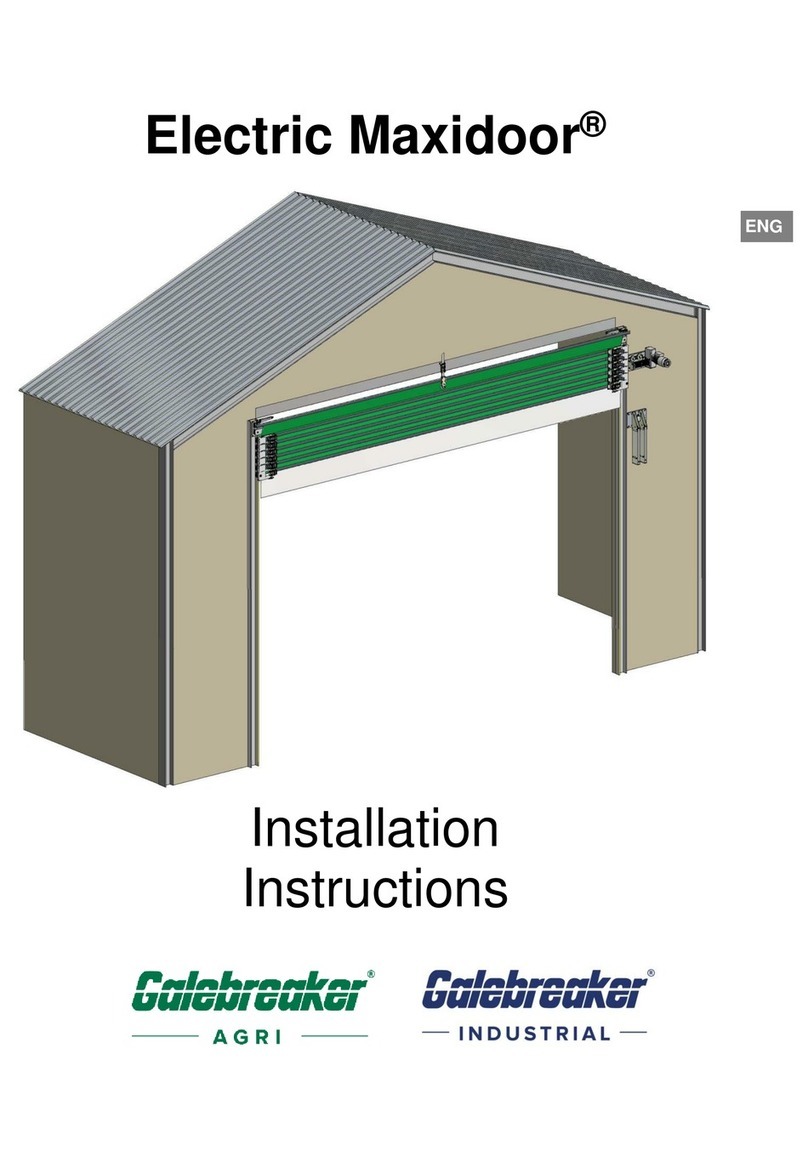
Galebreaker
Galebreaker Electric Maxidoor installation instructions

RIB
RIB K2007 manual
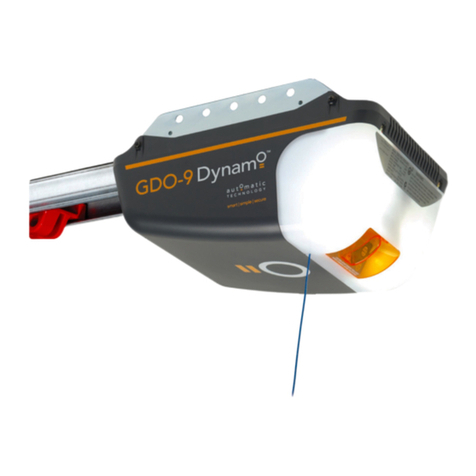
Automatic Technology
Automatic Technology GDO-9 Dynamo Gen 2 installation instructions
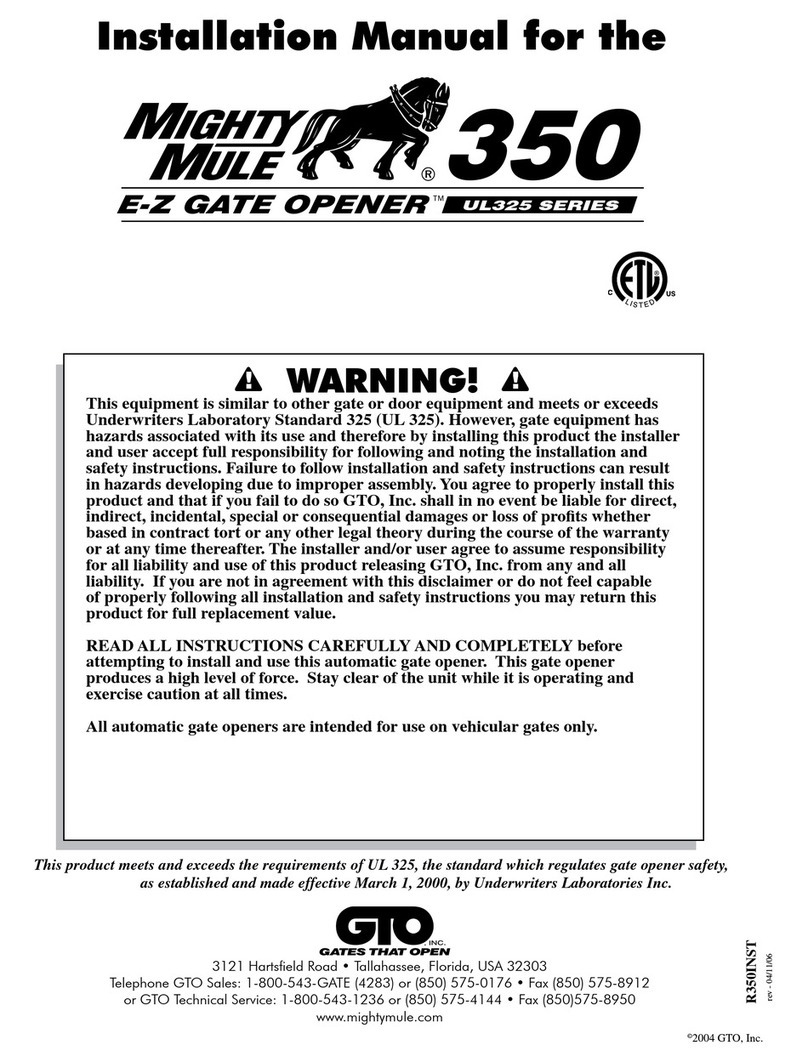
GTO
GTO UL325 SERIES installation manual
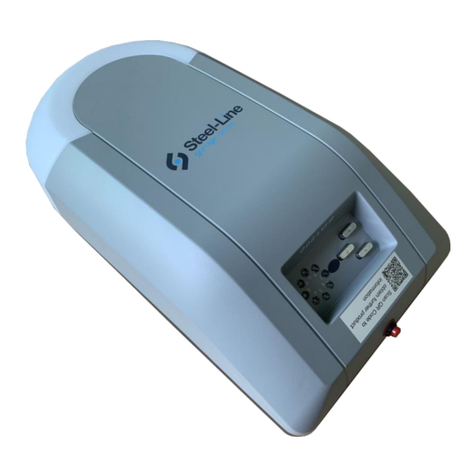
Steel-Line
Steel-Line SD1200 Installation and operating instructions
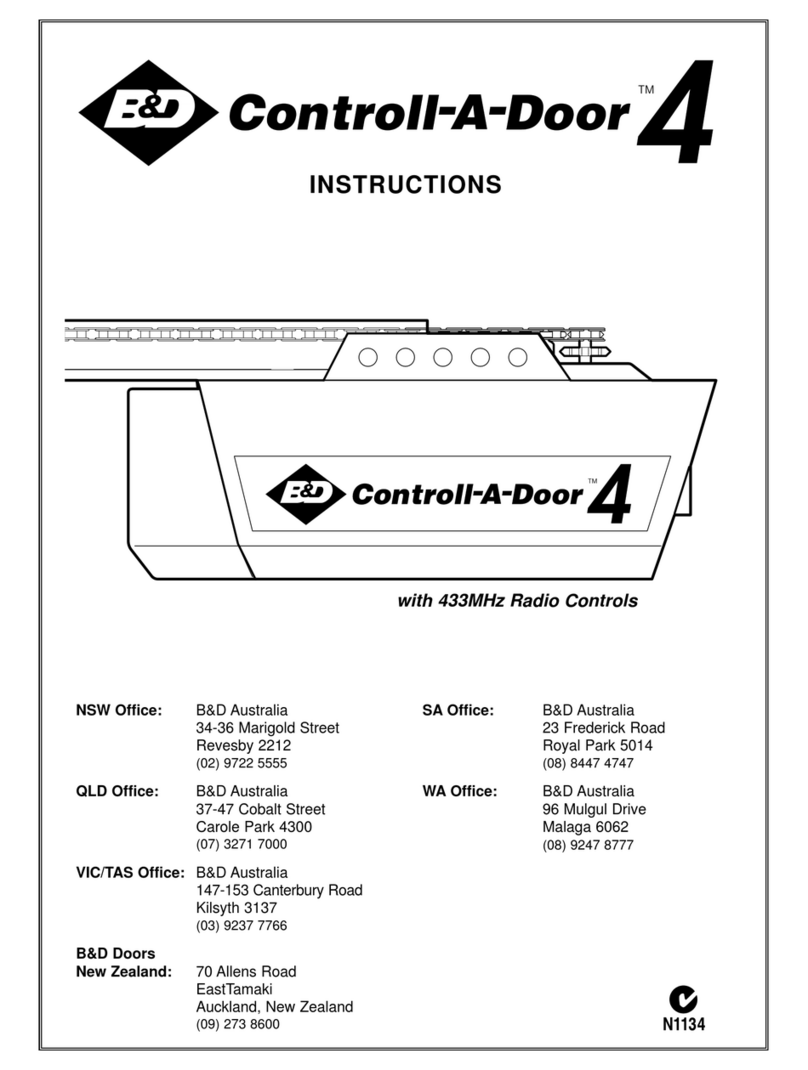
B&D
B&D Controll-A-Door 4 instructions
